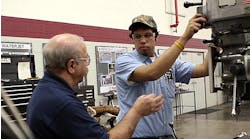A commodity is a product whose buyers base their purchase decisions on price and availability. Commodity market segments return substandard profits to most of their vendors, as the lion’s share of the business goes to the lowest-cost supplier. In most business-to-business markets, buyers pressure vendors to offer higher discounts, lower prices, and extra services. One tactic is to threaten taking the order to a competitor, who often will offer a lower price. The drum beat of downward pricing pressure convinces salespeople, sales managers and even some chief executives that low price is the major, or even the only, decision driver for their buyers. They gradually come to perceive their market segment as ‘commoditized.’
It is commonly thought that the closer we get to the Earth in producing raw materials, the harder it is to achieve Operational Excellence. While it seems tough enough to do in assembly plants, even in fabrication and machine shops, a foundry or diecasting plant where we are pouring molten metal is an entirely different story. But, different as it may be, the concepts of Operational Excellence still apply.
What is Operational Excellence? — Operational Excellence is not a “journey of continuous improvement.” It is not “excellence in everything we do” nor “creating a culture where every employee sees waste and eliminates it.” And, it is not about “getting better each day.” In fact, the latter is where Operational Excellence differs from traditional continuous improvement approaches.
Rather than a “never-ending journey” approach, Operational Excellence is a destination. And, that destination is defined as, “When each and every employee can see the flow of value to the customer and fix that flow before it breaks down.” There is even an “acid test” to let you know if you have achieved it: a visitor should be able to tell if you are on time to your customer needs just by walking through the operation, without asking any questions.
Creating “flow” — The first step towards Operational Excellence in a metalcasting operation is to establish a “flow” of product to the customer. The traditional tools for creating flow (cell design, balance charts, stack graphs, and so on) are primarily for assembly operations; they don’t apply to metalcasting operations. So, how do we create flow in a batch process that involves heavy setup and varying cycle times, and where process effectiveness counts? Enter the concept of “the interval.”
Academically, the interval means the period of time it will take to cycle through the mix of products in the family of parts that a machine produces. Does it take a month to go through all the part numbers, or a week, or a day? In practical terms, the concept of the interval determines our lot size and our lead-time. If we produce a part number only once per week, how many do we have to build when we run the part? The answer is one week’s worth, and the lead-time is also one week. If we run a part number every day, how many do we have to build when we run it? The answer is a day’s worth, and the lead-time is also one day. The time frame is not the key, however. The most important point is that we actually have established a timeframe, whatever it is.
Smaller intervals drive business growth — The larger the interval, the larger our batch size. The larger our batch size, the more management is needed to set priorities, schedules, and meetings, all in an effort to manage chaos to get the order to the customer. However, the smaller the interval, the more discipline that is required and the less chaos – and management intervention – that is incurred.
How does this impact business growth? The smaller the interval, the more part numbers can be processed in a shorter time period. The results in more flexibility to meet changing customer demand, and to offer small quantities with more frequent deliveries – both of which help to appeal to potential customers.
Setups are not setbacks — The smaller the interval, the more setups we will need. But, will that render us less effcient and add cost? Not really.
One thing the concept of the interval does is to help us establish what the setup times need to be in order to have the ability to produce a mix of part numbers that will satisfy our customers. Instead of setups being something to avoid, we can now link the ability to do setups directly to business growth.
Think of it this way: if we had the ability to change alloys instantly with no time lost, would it really matter what the customer ordered? We would not have to batch orders together anymore. And, our pouring process would be highly effective to match customer demand. Unfortunately, we probably don’t have instant setups. However, the issue is not how long our setups take, but rather how long they need to be to have a competitive advantage. In other words, instead of trying to reduce setup times to eliminate waste, we will know that a setup time of x, will yield us an interval of y, and an interval of y means opening the door to new customers.
Making flow visible — Once we have established the interval, we know how often and at what rate the mix of products should be produced. In other words, we have established a flow for a mix of products, or a rate at which different alloys can be produced. We have stated, “This is normal flow for us. If we don’t maintain this ability for producing a mix of alloys, then we know something is wrong with our flow.”
Once we draw that line, we need to make it visible for each and every employee to see so they will know the impact of achieving setup times in order to maintain the normal flow and satisfy customers. Each employee will know if the foundry operation is performing normally or if an abnormality in the flow is taking place. And, each employee can be taught how to fix abnormalities before they become catastrophic.
The result? We have created a metalcasting operation where each and every employee knows what to do in order to get the customer their order – perhaps the ultimate in process effectiveness.
| Kevin J. Duggan is an expert at applying advanced lean techniques and the author of three books on the subject: Design for Operational Excellence: A Breakthrough Strategy for Business Growth, Creating Mixed Model Value Streams, and The Office That Grows Your Business – Achieving Operational Excellence in Your Business Processes. Visit www.instituteopex.org |








